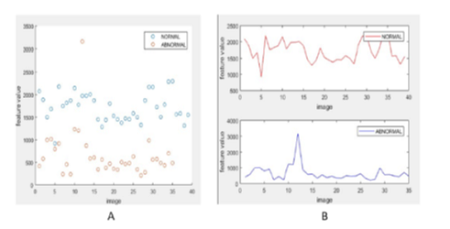


Indian Journal of Science and Technology
DOI: 10.17485/IJST/v14i26.2291
Year: 2021, Volume: 14, Issue: 26, Pages: 2152-2163
Original Article
Asim Ali Khan1*, Ajat Shatru Arora2
1Associate Professor, Sant Longowal Institute of Engineering and Technology, India
2Professor, Sant Longowal Institute of Engineering and Technology, India
*Corresponding Author
Email: [email protected]
Received Date:22 December 2020, Accepted Date:14 July 2021, Published Date:27 July 2021
Objective: To design a computer aided detection system for the early detection of the breast cancer from the mammograms as it can assist the doctors in the diagnosis. Methodology: The proposed method used in the design of Computer-Aided Detection (CAD) is based the on using the textural differences of the abnormal and normal mammograms to detect the breast cancer. The Gabor Features and gray-level co-occurrence matrix (GLCM) features are extracted from the region of interest of the segmented mammograms using the Entropy based segmentation. The Support Vector Machine (SVM) classifier is used for classifying the mammograms into the cancerous and non-cancerous cases. The 35 number of normal and abnormal mammograms are taken from the Mammographic Image Analysis Society (MIAS) data set. The MIAS database is chosen as it carries more challenging data because it carries lot of unwanted tissues and flesh part included in it which has the intensity level more than the micro-calcifications. Findings: The classification accuracies obtained are 92.98% and 98.11% using Gabor and gray-level co-occurrence matrix features respectively. The sensitivity achieved with the gray-level co-occurrence matrix features is 100% which shows no missed cancerous case. The classification accuracy is higher using gray-level co-occurrence matrix features as compared to the Gabor features which shows superiority of these features in capturing the texture of the mammograms. Novelty: The removal of the pectoral muscle is an important pre-processing step. Only with the proper elimination of the pectoral muscle, the segmentation of the mammograms is possible. The method proposed to remove the pectoral muscle in this paper removed the pectoral muscles from all the mammograms used in the study. The entropy based segmentation and the technique of the removal of the non-contributing features outperforms other CAD systems in the literature available. These are very promising results for successful design of a Computer-aided detection system for early detection of the breast cancer that can be put to clinical trials or used for the double reading.
Keywords: Breast Cancer; Computer Aided Detection System; Entropy based Segmentation; Gabor Features; GrayLevel CoOccurrence Matrix Features
© 2021 Khan & Arora. This is an open-access article distributed under the terms of the Creative Commons Attribution License, which permits unrestricted use, distribution, and reproduction in any medium, provided the original author and source are credited. Published By Indian Society for Education and Environment (iSee)
Subscribe now for latest articles and news.